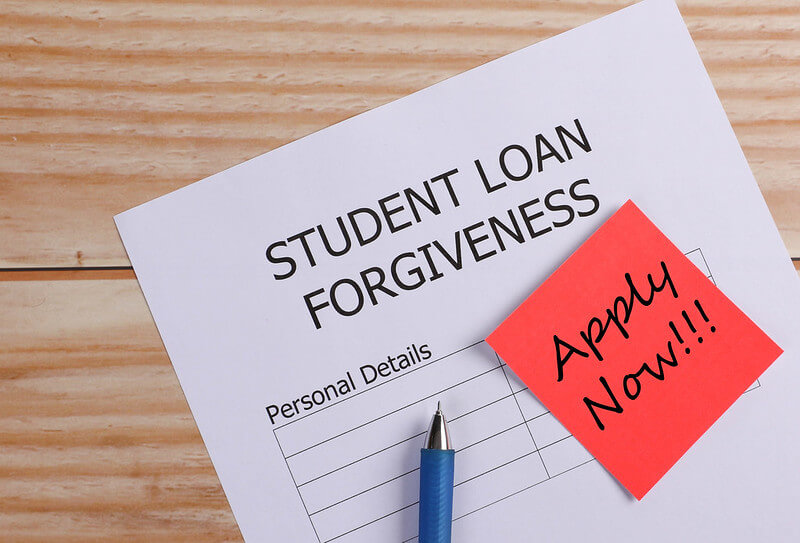Student Loan Forgiveness: Everything You Need to Know

There has been a lot of talk in recent weeks about student loan forgiveness. As a college student or a recent graduate, this could greatly impact you in the years or even months to come.
But is it everything it’s cracked up to be? And what do you have to do to qualify and apply? In this article, we’ll be examining the answers to these and other questions. Let’s begin!
What is student loan forgiveness, and how does it work?
Student loan forgiveness is a process in which borrowers can have their remaining student loan balance forgiven by the government. In order to qualify, borrowers must make 120 qualifying monthly payments on an eligible repayment plan while working full-time for an eligible employer.

Once borrowers have made the required number of payments, the remaining balance on their student loan will be forgiven. Although student loan forgiveness is often thought of as a federal program, there are also state and private programs that offer forgiveness for certain types of loans.
For example, the Public Service Loan Forgiveness Program forgives the remaining balance on Direct Loans for borrowers who work in public service. Other programs may forgive loans for teachers, nurses, or doctors. Borrowers who are interested in pursuing student loan forgiveness should research the various programs to see if they qualify.
The pros of student loan forgiveness
- Loan Forgiveness Can Help to Boost the Economy: When graduates are struggling to repay their student loans, they are less likely to spend money on big-ticket items like homes and cars. This can lead to a decrease in consumer spending, which can in turn lead to a decrease in economic growth. By forgiving student loans, the government can help to encourage spending and boost the economy.
- Loan Forgiveness Can Help Reduce Inequality: Student loan debt disproportionately affects low-income and middle-class borrowers. Forgiving student loans can help to reduce inequality and level the playing field for all borrowers.
- Loan Forgiveness Can Encourage More People to Pursue Higher Education: The high cost of tuition can dissuade many people from pursuing higher education. If student loans were forgiven, more people would be able to afford to go to college, leading to a more educated workforce.
- Loan Forgiveness Can Help Alleviate Borrower Stress: Student loan debt is a major source of stress for many Americans. Forgiving loans can help to reduce this stress and improve borrowers’ mental health.
- Loan Forgiveness Programs Can Be Targeted: Not all loan forgiveness programs are created equal. Some programs, like the Public Service Loan Forgiveness Program, are specifically targeted toward certain professions, such as teachers or doctors. This can ensure that the forgiveness goes to those who truly need it and are likely to use it to further their career.
The cons of student loan forgiveness
Student loan forgiveness sounds like a great idea, but there are actually quite a few cons to consider. First of all, student loan forgiveness would be a huge windfall for people who took out loans to attend expensive schools.
That means that people who could afford to pay their loans would get a free ride, while those who struggled to make ends meet would still be on the hook. Additionally, student loan forgiveness would be a huge financial burden for the government.
The cost of forgiving all outstanding student loans would run into trillions of dollars, and there’s no guarantee that it would actually boost the economy as intended. Finally, student loan forgiveness would send a message that debt is no big deal and that it’s okay to borrow without consequences.
That could lead to even more people taking on excessive debt, which would eventually hurt the economy. In conclusion, there are several serious downsides to student loan forgiveness that should be considered before moving forward with such a policy.
Who qualifies for student loan forgiveness?
To qualify for student loan forgiveness in the United States, you must first have federal student loans. You can not have private student loans or any other type of loan. Secondly, you must be employed full-time by a qualifying employer.
Qualifying employers include government organizations, 501(c)(3) nonprofit organizations, and some for-profit organizations. You must also be employed in a qualifying career field, which includes teaching, law enforcement, public interest law, nursing, military service, social work, public service, or early childhood education.
Thirdly, you must make 120 payments on your student loans. Payments made while you are in school or during a grace period do not count towards the 120 payments.
Payments made under certain repayment plans may also count towards the 120 payments required for forgiveness. For example, payments made under the Income-Based Repayment Plan (IBR), Pay As You Earn Plan (PAYE), or Revised Pay As You Earn Plan (REPAYE) all count towards loan forgiveness.
Finally, after making 120 payments, any remaining balance on your student loan will be forgiven. However, you may have to pay taxes on the amount that is forgiven. Forgiven student loan debt is considered taxable income by the IRS.
How to apply for student loan forgiveness
The process of applying for student loan forgiveness in the United States is a lengthy and complicated one. First, borrowers must have made 120 qualifying payments on their loans. This typically takes 10 years, but there are some exceptions for those who work in public service or have other extenuating circumstances.
Once the 120 payments have been made, borrowers must submit an application to their loan servicer. The application must include documentation of the payments made, as well as proof of employment and income.
After the application has been reviewed, the loan servicer will determine whether the borrower qualifies for forgiveness. If approved, the remaining balance of the loan will be forgiven. However, if the borrower does not qualify, they may be required to continue making payments on their loans.
What to do if you don’t qualify for student loan forgiveness
The federal government offers student loan forgiveness programs for individuals who work in certain public service jobs. However, these programs typically have strict eligibility requirements, and not everyone who works in a public service job will qualify.
If you are a graduate who does not qualify for student loan forgiveness, there are still several options available to you. First, you may be able to consolidate your loans or refinance them at a lower interest rate.
Additionally, you can explore income-driven repayment plans, which can lower your monthly payments based on your income and family size. Finally, if you are having difficulty making your payments, you can contact your loan servicer to discuss your options. Although student loan forgiveness is not an option for everyone, there are still several ways to manage your loans and keep your payments affordable.
Alternatives to student loan forgiveness
There are a number of alternatives to student loan forgiveness worth considering. One option is to refinance your loans at a lower interest rate. This can save you money over the life of your loan and may make your monthly payments more manageable.
Another option is to consolidate your loans into one single payment. This can also help to lower your monthly payments and may make it easier to stay on top of your loan obligations. Finally, you may want to consider enrolling in an Income-Based Repayment plan.
This type of plan allows you to make monthly payments based on your income and can forgive any remaining balance after 20 or 25 years. These are just a few of the alternatives to student loan forgiveness worth considering. Talk to your loan provider about which option may be right for you.
The Push For Student Loan Forgiveness Is Growing
Student loan forgiveness may not go as far as you would like it to. That’s at least the case in the short term. But it’s closer to reality now than it has been for a good number of students living in debt.
Following the steps presented above will get you closer to obtaining student loan forgiveness for all or a portion of your outstanding debt. Just be mindful of the pros and cons before you do to decide to put in the effort. Good luck!
[Featured Image by Flickr Creative Commons License]








